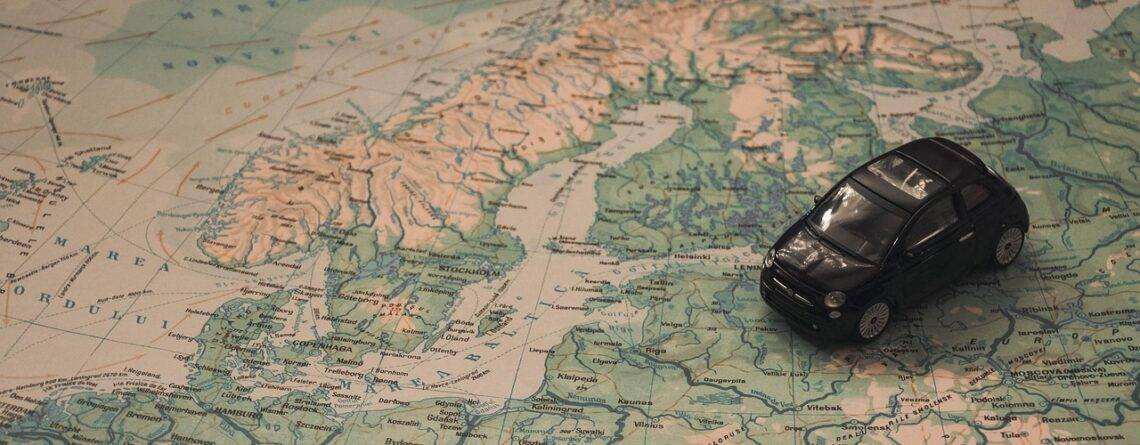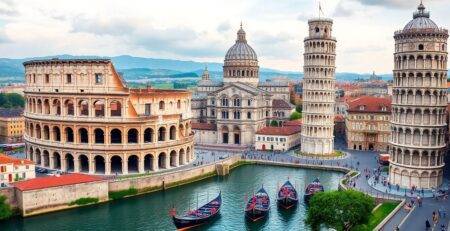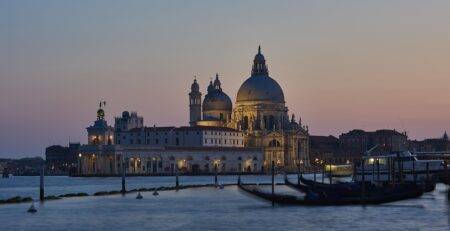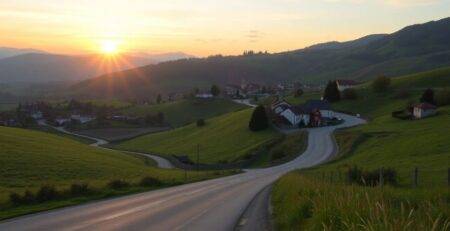I’ve been itching to break out of the usual tourist loop and find some underrated european cities to visit in 2025. So I spent months hopping trains, chasing cheap flights, and yes, getting hopelessly lost a few times. What I ended up with is a list of ten spots that hardly anyone talks about but that really stuck with me.
Key Takeaways
- Riga charms with its art nouveau streets and a laid-back vibe far from the usual Baltic buzz.
- Cluj-Napoca mixes a young crowd, lively student bars, and cutting-edge street art in Romania’s heart.
- Ljubljana feels like a small capital made for strolling—cute bridges, river cafés, and no mad crowds.
- Ghent surprises with medieval lanes, a cool music scene, and plenty of canals without the Amsterdam rush.
- Tallinn’s old town is straight out of a fairy tale, and nearby forests and islands make it more than just cobblestones.
1. Riga

I’ve always been drawn to cities that offer a unique blend of history, culture, and affordability, and Riga, the capital of Latvia, ticks all those boxes. It’s a city that surprised me in the best way possible, and I think it deserves a spot on everyone’s travel list for 2025.
One of the first things that struck me about Riga was its stunning architecture. The city boasts one of the finest collections of Art Nouveau buildings in Europe, and simply wandering through the streets is like stepping back in time. Alberta Street is a must-see, with its facades adorned with intricate details and vibrant colors. I spent hours just gazing up at the buildings, completely mesmerized.
Riga Capital of Latvia
Beyond the architecture, Riga’s Old Town is an absolute gem. The cobblestone streets, medieval buildings, and charming squares create an atmosphere that’s both romantic and inviting. I loved getting lost in the maze of alleyways, discovering hidden cafes and shops along the way. The House of the Blackheads and St. Peter’s Church are iconic landmarks that shouldn’t be missed. I found a canal boat sightseeing tour that gave me a unique perspective of the city.
Riga also offers plenty of green spaces to escape the hustle and bustle of city life. Bastejkalna Park, located right in the heart of the city, is a peaceful oasis where you can relax by the canal, admire the flowerbeds, or simply watch the world go by. It’s the perfect spot for a picnic or a leisurely stroll.
Here are a few things I particularly enjoyed in Riga:
- Exploring the Central Market, one of Europe’s largest and most vibrant markets.
- Taking a day trip to Jurmala, a seaside resort town just a short train ride from Riga.
- Enjoying the city’s vibrant nightlife, with its many bars, clubs, and live music venues.
Riga is a city that’s easy on the wallet, making it an ideal destination for budget-conscious travelers. Accommodation, food, and transportation are all relatively affordable, allowing you to experience the city without breaking the bank.
Overall, Riga is a city that has something to offer everyone. Whether you’re interested in history, culture, architecture, or simply soaking up the atmosphere of a charming European capital, Riga won’t disappoint. I highly recommend adding it to your travel plans for 2025.
2. Cluj-Napoca

I spent a good chunk of time backpacking in Romania, and Cluj-Napoca really stood out. It’s a vibrant city with a cool, youthful energy, largely thanks to its big student population. It’s definitely one of the best summer destinations in Europe.
Cluj-Napoca offers a great mix of history, culture, and nightlife, all without the crazy crowds you find in other European hotspots.
I found myself wandering through its charming streets, checking out the architecture, and just soaking up the atmosphere. Plus, it’s super affordable, which is always a bonus.
I think what I liked most about Cluj was its authenticity. It felt like a real city, not just a tourist trap. People were going about their daily lives, and I got a genuine sense of Romanian culture.
Here’s a few things I really enjoyed:
- Exploring the Central Park, a perfect spot for a relaxing afternoon.
- Visiting St. Michael’s Church, a stunning example of Gothic architecture.
- Checking out the local markets for some tasty Romanian treats.
3. Ljubljana

Ljubljana, the capital of Slovenia, wasn’t initially high on my travel list, but I’m so glad I finally made it there. It’s one of those places that just surprises you with its charm. Compared to other European capitals, it’s smaller, but it packs a punch.
I found that the city has a really calm, laid-back vibe. It’s perfect for just wandering around, especially along the Ljubljanica River. I spent a good chunk of my time just sitting at riverside cafes, soaking it all in. You won’t find that sense of rush that you get in so many other cities.
Ljubljana was named Europe’s Green Capital back in 2016, and you can really feel it. The car-free city center is a huge plus, and there are parks everywhere. Plus, you’re never really far from nature, which is a nice bonus.
Here are a few things I particularly enjoyed:
- Exploring the picturesque Old Town with its cobblestone streets.
- Crossing the iconic Dragon Bridge.
- Enjoying the abundance of green spaces.
If you’re looking for budget-friendly travel destinations that offer something a little different, Ljubljana should definitely be on your radar.
4. Ghent

Ghent, Belgium, often gets overshadowed by Bruges and Brussels, but honestly, I think it’s a hidden gem that deserves way more attention. I visited Ghent last spring, and I was completely charmed by its unique blend of medieval architecture and modern vibes. It’s like stepping back in time, but with amazing coffee shops and street art around every corner.
I spent a lot of time just wandering along the canals, taking in the views of the Graslei and Korenlei. The architecture is stunning, and the atmosphere is just so relaxed. It’s a great place to escape the crowds and experience a different side of Belgium.
Here are a few things I really enjoyed:
- Exploring Gravensteen Castle: This medieval castle is seriously impressive, and the views from the top are incredible.
- Taking a boat tour: It’s a great way to see the city from a different perspective and learn about its history.
- Trying local beers: Belgium is famous for its beer, and Ghent has plenty of great pubs and breweries to choose from.
I found Ghent to be a really walkable city, and I loved getting lost in its narrow streets. The food scene is also fantastic, with plenty of options for every taste and budget. I’d recommend trying the local specialty, Waterzooi, a creamy chicken or fish stew.
Ghent is a city that surprised me in the best way possible. If you’re looking for an underrated European destination with a lot to offer, I highly recommend adding it to your list for 2025.
5. Tallinn
Tallinn, Estonia, is a city that’s been steadily climbing my list of must-visit places, and I think 2025 is going to be its year. It’s got this amazing blend of medieval charm and modern innovation that just works. I’m picturing myself wandering through the cobblestone streets of the Old Town, a UNESCO World Heritage site, and soaking in all that history.
The city’s well-preserved medieval fortifications are a sight to behold. I’m also excited to check out the local design scene, which I’ve heard is really taking off. Plus, it’s supposed to be pretty affordable compared to other European capitals, which is always a bonus. If you’re looking for budget-friendly adventures, Tallinn should be on your radar.
I’ve heard whispers about Tallinn’s food scene too, and I’m eager to try some traditional Estonian dishes. Apparently, there are some really cool restaurants popping up that are putting a modern twist on classic recipes. I’m already drooling thinking about it.
Here’s a few things I’m planning to do:
- Explore Toompea Hill for panoramic views.
- Visit the Alexander Nevsky Cathedral.
- Take a day trip to Lahemaa National Park.
6. Maastricht

Okay, so Maastricht. I visited a few years back, and it’s one of those places that just sticks with you. It’s in the southeast of the Netherlands, and honestly, it’s got that classic European vibe that everyone dreams about. I think the old town is the real draw, with its charming streets and historic buildings.
It’s super easy to get to from other major cities, like Amsterdam or Brussels, making it a great day trip option. But trust me, you’ll probably want to stay longer. I always suggest it when people are planning a trip to the Netherlands because most only think of Amsterdam. If you are looking for a way to see the city, consider guided tours to get the most out of your visit.
Here are a few things I really enjoyed:
- The Bookstore Dominicanen: It’s in an old church! How cool is that?
- The medieval architecture: Just wandering around is a treat.
- Trying local food: Definitely join a gastronomic tour if you can!
Maastricht is a hidden gem. It’s got history, culture, and great food, all without the crazy crowds you find in other European cities. It’s a perfect spot for a relaxed and enjoyable getaway.
7. Lecce
Lecce, often called the “Florence of the South,” is a city that completely charmed me. I wasn’t expecting to fall so hard for its Baroque architecture and laid-back vibe. It’s a place where you can wander through narrow streets, stumble upon stunning churches, and enjoy some seriously delicious food without the overwhelming crowds of other Italian cities. Seriously, it’s a hidden gem that deserves way more attention.
I think the best part about Lecce is its authenticity. It feels like a real Italian city, not just a tourist trap. The locals are friendly, the prices are reasonable, and the atmosphere is just magical. I spent days exploring its hidden corners, and I still feel like I barely scratched the surface. If you’re looking for an Italian experience that’s off the beaten path, Lecce should be at the top of your list.
I found myself just sitting in piazzas, sipping espresso, and watching the world go by. It’s the kind of place where you can truly relax and soak in the Italian culture. Plus, the pastries are to die for!
Here are a few things I particularly enjoyed:
- The Basilica di Santa Croce: An absolute masterpiece of Baroque architecture.
- The Roman Amphitheatre: A glimpse into Lecce’s ancient past.
- The local cuisine: Fresh seafood, handmade pasta, and of course, pasticciotto (a local pastry).
And if you’re planning a one-week European road trip, Lecce makes a fantastic stop!
8. Kotor
Okay, Kotor. I’ll admit, part of me doesn’t want to include it on this list because it feels like the secret is already out. But, it’s still underrated compared to other European hotspots, so here we are. Nestled on the Adriatic coast of Montenegro, Kotor is like stepping into a postcard. The bay itself is stunning, with dramatic mountains rising straight from the water. It’s almost fjord-like, which is pretty unexpected in the Mediterranean.
The old town is a maze of cobblestone streets, Venetian architecture, and hidden squares. I spent hours just wandering around, getting delightfully lost. You’ll find charming cafes, local shops, and a surprising number of cats lounging in sunny spots. It’s a photographer’s dream, seriously.
One of the best things I did was hike up to the fortress of St. John. It’s a bit of a climb – think lots of stairs – but the panoramic views of the bay are absolutely worth it. Trust me on this one. Bring water, though; you’ll need it.
Here’s a few things I recommend doing:
- Explore the Old Town’s Venetian architecture.
- Hike to the Fortress of St. John for incredible views.
- Take a boat trip around the Bay of Kotor.
- Visit the nearby town of Perast.
- Indulge in some fresh seafood at a local restaurant.
Kotor is a place that gets under your skin. It’s beautiful, historic, and has a laid-back vibe that’s hard to resist. Go before everyone else does!
9. Kaunas

Kaunas, Lithuania’s second-largest city, often gets overshadowed by Vilnius, but I think it’s a real gem. I spent a long weekend there last summer, and I was completely charmed by its unique vibe. It’s got this cool mix of history and modern culture that I found super appealing. It’s definitely a place I’d recommend if you’re looking for something a little different.
One of the things that struck me most about Kaunas was its architecture. The city is known for its interwar modernist architecture, which is unlike anything I’ve seen anywhere else. It’s a UNESCO World Heritage site now, and you can really see why. I spent hours just wandering around, admiring the buildings. I think you should explore Kaunas and its unique charm.
I found the people in Kaunas to be incredibly friendly and welcoming. They were always happy to help with directions or offer recommendations for things to see and do. It really made my trip that much more enjoyable.
Here are a few things I think you should check out:
- Laisvės Alėja (Liberty Avenue): The main pedestrian street, perfect for a stroll and people-watching.
- Kaunas Castle: A historic castle at the confluence of the Nemunas and Neris rivers.
- The Devil’s Museum: A quirky and unique museum with a collection of devil-related artifacts from around the world.
10. Tartu
Tartu, Estonia, often gets overshadowed by its more famous sibling, Tallinn. But honestly, I think that’s a mistake. While Tallinn is undeniably beautiful and historic, Tartu offers a different, more laid-back vibe that I found incredibly appealing. It’s a university town, so there’s a youthful energy that permeates everything, from the cafes to the street art. I spent a few days wandering around, and I was constantly surprised by the hidden gems I stumbled upon.
Tartu is a city where history and modernity blend seamlessly. The historic buildings house innovative startups, and the traditional pubs are filled with students discussing the latest tech trends. It’s a place where you can feel the pulse of Estonia’s future while still appreciating its rich past.
One of the things that struck me most about Tartu was its commitment to culture. There are museums galore, covering everything from art to science to history. And the street art scene is thriving, with colorful murals popping up in unexpected places. I also really enjoyed the food scene. There are tons of great restaurants and cafes, serving everything from traditional Estonian cuisine to international fare. And the prices are generally much lower than in Tallinn, which is always a plus.
Here are a few things I particularly enjoyed:
- Visiting the University of Tartu’s main building. It’s a stunning example of classical architecture.
- Exploring the Aparaaditehas, a former factory complex that’s been transformed into a hub for creative businesses and artists.
- Taking a walk along the Emajõgi River. It’s a beautiful and peaceful way to see the city.
Tartu is a city that’s easy to fall in love with. It’s charming, vibrant, and full of surprises. If you’re looking for an underrated European city to visit in 2025, I highly recommend adding Tartu to your list. You might even find some trendy cafes to relax in.
## Conclusion
I loved putting together this list of underrated cities. Some of them really caught me off guard and made me scribble notes in my notebook. I still smile thinking about ducking into that tiny bakery in Brno and ending up in a chat with the owner for almost an hour. If you pick one of these spots for your next trip and things go off plan, don’t sweat it—you might just stumble on your favorite street corner instead of another crowded landmark. And hey, if you have a hidden gem to share, drop it in the comments. I’m always game for swapping travel tips and planning my next surprise detour!
Frequently Asked Questions
When is the best time to visit these cities?
I usually go in late spring or early fall. The weather is mild and the crowds are smaller, so I can enjoy walking around without bumping into too many people.
How can I travel on a budget?
I often watch for low-cost airline deals and use local buses or trains once I land. Staying in small guesthouses or hostels also helps me save money.
How many days should I spend in each city?
I think 2 to 3 days gives you enough time to see the main sights and soak up the local vibe without rushing.
Are these cities safe for solo travelers?
I’ve felt safe walking the streets in all of them, even at night. I still take normal precautions, like avoiding dark alleys and keeping an eye on my things.
Do I need to speak the local language?
I found that English works in most cafés and shops. Learning a few basic phrases in the local language always makes me feel more connected, though.
What kind of budget should I plan for daily expenses?
I aim for about $60 to $80 a day. That covers a modest meal, public transport, and a small entry fee or two.





Comment (1)
uie13u
Comments are closed.